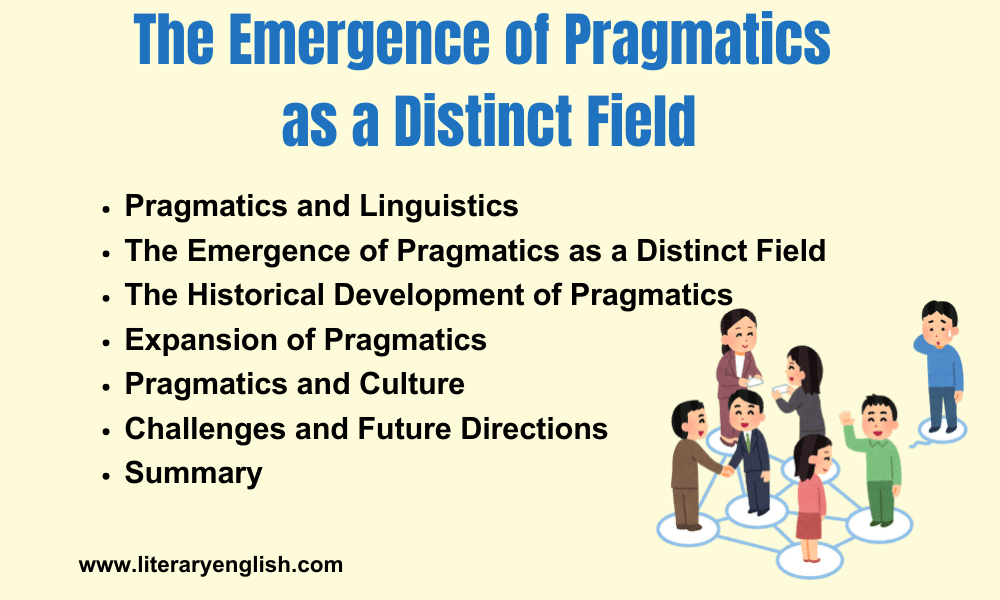In the field of linguistics, the study of language goes beyond the analysis of its grammatical structure and meaning. Pragmatics, a subfield of linguistics, focuses on the study of language in use and how meaning is constructed through context, social interactions, and cultural factors. Over the years, pragmatics has emerged as a distinct field, shedding light on the intricacies of language beyond its structural properties. This article delves into the emergence of pragmatics as a separate discipline within linguistics, exploring its key concepts, applications, and future directions.
Pragmatics and Linguistics
Linguistics is an academic field that focuses on analyzing, describing, and explaining human language. On the other hand, Pragmatics is commonly regarded as a branch of linguistics that specifically examines the interaction between language and its context. It should be noted that pragmatics lies outside the main core of linguistics, which includes phonology, morphology, syntax, and semantics. These core areas primarily concern themselves with studying language as a self-contained and formal system. In contrast, pragmatics is concerned with the practical use and interpretation of language within its context. Rather than being a language in itself, pragmatics serves as a complement to linguistic theory. It has been metaphorically referred to as the “wastebasket of linguistics.” According to Kasher (1998:104), although Chomsky’s work has primarily focused on syntax, his objective and scientific methodology can extend beyond syntax and be applied to other interesting areas, including pragmatics.
The Emergence of Pragmatics as a Distinct Field
During the 1970s, the term “pragmatics” came into use to describe a distinct field of study alongside syntax and semantics. Different philosophers engaged in discussions about formal languages were using the term in various ways during that time. One such philosopher was Montague, a formal semanticist who mentioned pragmatics in the late 1960s. Bar-Hillel also employed this term in the 1950s, referring to pragmatics as the study of languages that contain indexical terms.
According to Levinson’s observations, this broad definition of pragmatics would encompass the study of all natural languages since they all possess elements that can be considered indexical. The modern understanding of pragmatics in philosophy emerged in the late 1960s. Gazdar noted that by the late 1970s, pragmatics had gained recognition as a legitimate sub-discipline within linguistics, although it wasn’t widely acknowledged in the early 1970s. The rise of linguistic pragmatics seems to have been influenced significantly by the dissemination of Grice’s Logic and Conversation lectures, which were circulated in mimeograph form from the late 1960s onwards.
The Historical Development of Pragmatics
The origins of pragmatics can be traced back to the mid-20th century, with the works of philosophers and linguists such as Ludwig Wittgenstein, John Austin, and Paul Grice. These scholars emphasized the importance of understanding language in its use and social context, highlighting that meaning is not solely derived from the words themselves but also from the intentions and implicatures conveyed by the speaker.
Expansion of Pragmatics
Pragmatics, a field of linguistics that focuses on the study of practical aspects of language use, has roots tracing back to ancient Greece and Rome. In those times, the terms “pragmaticus” in late Latin and “pragmaticos” in Greek were used, both conveying the idea of being practical. However, the modern development and application of pragmatics can be attributed to the American philosophical doctrine of pragmatism. Notably, Charles Morris’ work in his book “Foundations of the Theory of Signs” (1938) presented a pragmatic interpretation of semiotics and verbal communication, effectively highlighting the distinctions between mainstream endeavors in semiotics and linguistics.
In 1975, Grice brought attention to the significance of conversational meanings, contributing to the contemporary understanding of meaning by differentiating between natural and non-natural meaning. According to Grice, pragmatics should primarily focus on the practical dimension of meaning, specifically conversational meaning. This concept was further developed by scholars like Levinson (1983) and Leech (1983). Moreover, practical considerations led to the seminal discoveries of the Cooperative Principle by Grice (1975) and the Politeness Principle by Leech (1983). The influence of pragmatism has also fostered cross-linguistic international studies on language usage, culminating in the development of Sperber and Wilson’s relevance theory (1986).
Pragmatics and Culture
Culture significantly influences language use and interpretation. Pragmatics acknowledges the impact of cultural norms, values, and beliefs on communication patterns and meaning. It explores cross-cultural differences in speech acts, politeness strategies, indirectness, and other pragmatic phenomena. Understanding the cultural dimensions of pragmatics is vital for effective intercultural communication.
Challenges and Future Directions in Pragmatics
As a rapidly evolving field, pragmatics faces several challenges and offers exciting prospects for future research. Some challenges include the development of reliable pragmatic assessment tools, the integration of pragmatics into language curricula, and the exploration of pragmatics in multilingual and multicultural contexts. The future of pragmatics lies in uncovering the intricate dynamics of language use and understanding its implications for diverse communication settings.
Conclusion
The emergence of pragmatics as a distinct field in linguistics has significantly enriched our understanding of language and communication. By examining how language is used in context, pragmatics sheds light on the intricate mechanisms through which meaning is constructed, conveyed, and interpreted. Its study of speech acts, implicatures, presuppositions, and cultural influences has far-reaching implications for language teaching, intercultural communication, and the analysis of discourse. As pragmatics continues to evolve, it promises to unveil further insights into the complex interplay between language, context, and meaning.
